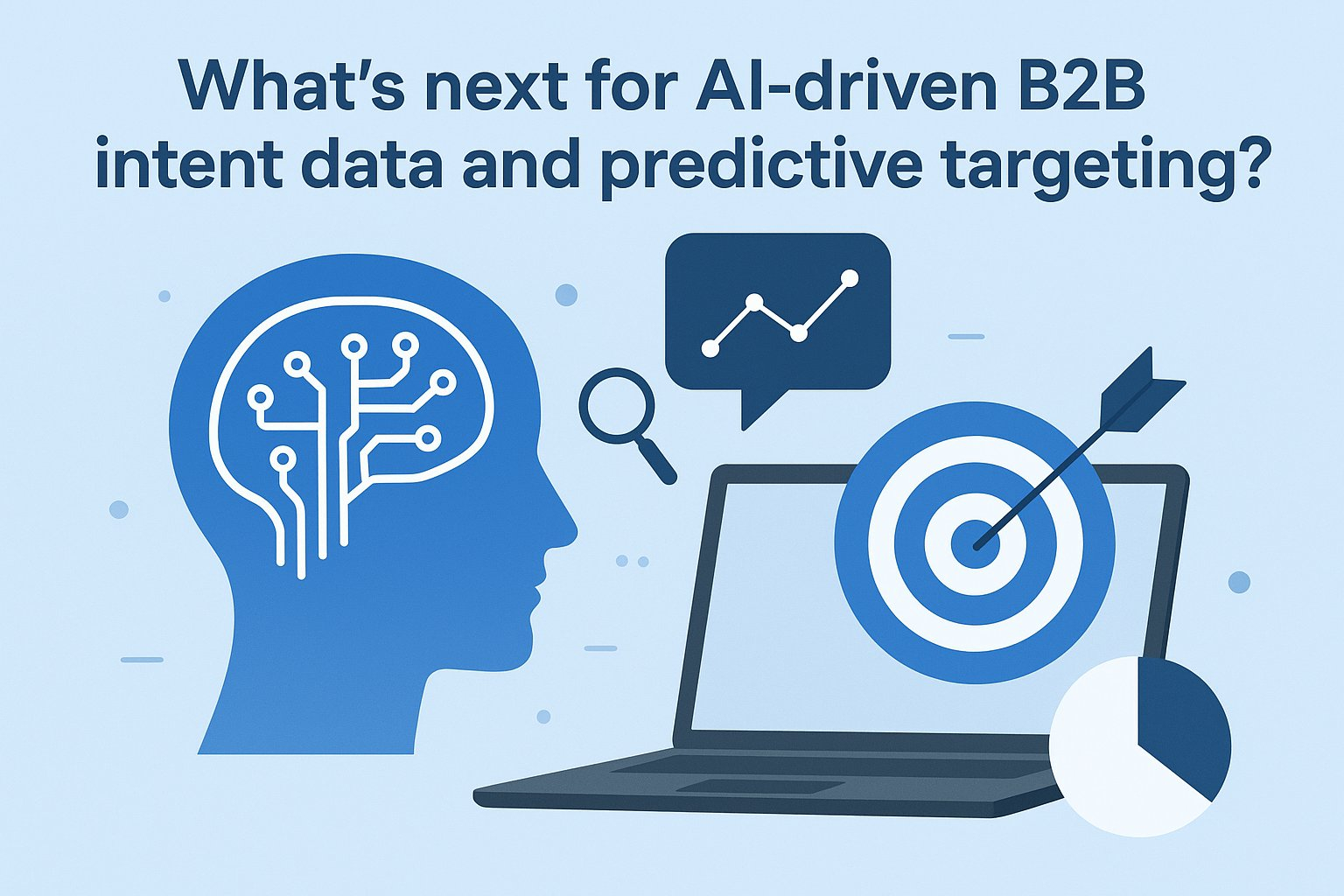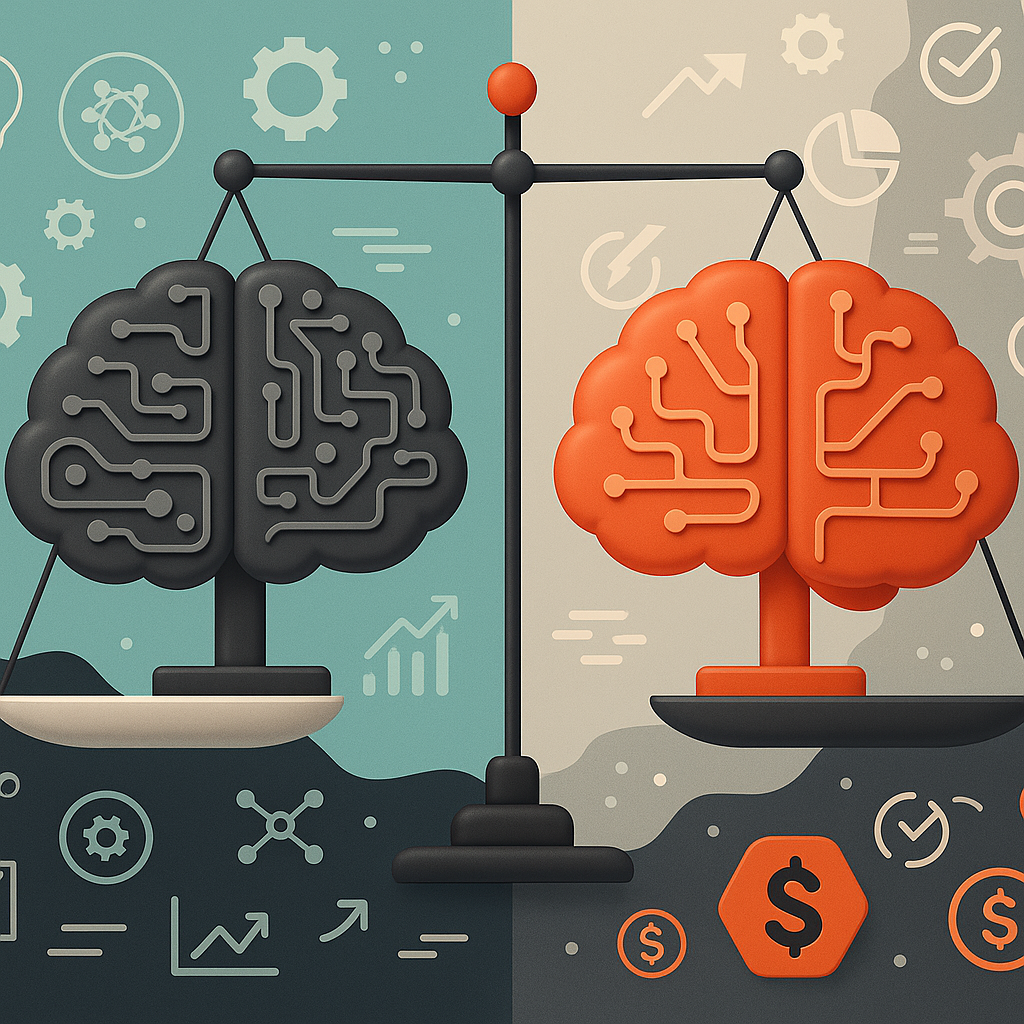What’s next for AI-driven B2B intent data and predictive targeting?
B2B marketing has always been about timing—reaching the right buyer at the precise moment they’re ready to act. With AI supercharging intent data and predictive targeting, that precision is evolving into prediction. The question isn’t who your next customer is anymore—it’s when they’ll buy and how to engage them most effectively.
So, what’s next for AI-driven intent data and predictive targeting in the B2B space? Let’s take a look.
1. Real-Time Intent Detection Becomes the Norm
Today’s intent models analyze behavior from websites, content interactions, and third-party platforms. The next phase will bring real-time intent detection, powered by AI models that process live data streams.
• AI will identify buying signals (like sudden topic research spikes or competitor engagement) as they happen, enabling marketers to act within hours—not weeks.
• Platforms like 6sense, Bombora, and Demandbase are already evolving in this direction, with adaptive scoring that updates continuously.
Impact: Faster, more responsive targeting that aligns perfectly with shifting buyer intent.
2. Multisource Data Fusion for 360° Buyer Intelligence
AI will unify diverse data types—firmographics, technographics, content engagement, CRM activity, and even psychographic insights—into a single predictive framework.
• This fusion will eliminate siloed data, allowing AI to “see” patterns across touchpoints and create deeper audience profiles.
• Expect predictive engines that can distinguish between casual researchers and serious buyers by weighing dozens of cross-channel behaviors simultaneously.
Impact: Sharper segmentation and more accurate prioritization of high-value accounts.
3. Predictive Engagement Timing and Channel Optimization
Future AI systems won’t just identify who to target—they’ll predict when and where to engage.
• Predictive timing models will forecast the optimal moment to send an email, launch an ad, or trigger sales outreach.
• AI will recommend the best content type and channel—video, email, or webinar—based on each buyer’s behavioral history.
Impact: Higher engagement and conversion rates driven by perfectly timed outreach.
4. Privacy-First Predictive Modeling
As data regulations tighten globally, AI will shift toward privacy-preserving intent models.
• Techniques like federated learning and synthetic data generation will allow platforms to predict buyer intent without exposing personally identifiable information (PII).
• Ethical AI frameworks will become core to how predictive targeting operates.
Impact: Predictive accuracy without compromising trust or compliance.
5. Self-Learning Predictive Pipelines
The next generation of predictive targeting will feature autonomous learning loops.
• AI will continuously retrain itself using new CRM outcomes—adjusting scoring weights, refining signals, and improving predictions over time.
• Human marketers will shift from manual campaign tuning to strategy and creative direction.
Impact: Constant optimization and sustained accuracy at scale.
The Bottom Line:
AI-driven intent data and predictive targeting are moving from descriptive to prescriptive intelligence—from observing behavior to anticipating it. In the next 3–5 years, B2B marketers will rely on AI systems that don’t just identify who’s ready to buy but can forecast when, how, and why. The result? Shorter sales cycles, higher ROI, and a marketing ecosystem that learns, adapts, and performs autonomously.
Read More: https://intentamplify.com/lead-generation/
B2B marketing has always been about timing—reaching the right buyer at the precise moment they’re ready to act. With AI supercharging intent data and predictive targeting, that precision is evolving into prediction. The question isn’t who your next customer is anymore—it’s when they’ll buy and how to engage them most effectively.
So, what’s next for AI-driven intent data and predictive targeting in the B2B space? Let’s take a look.
1. Real-Time Intent Detection Becomes the Norm
Today’s intent models analyze behavior from websites, content interactions, and third-party platforms. The next phase will bring real-time intent detection, powered by AI models that process live data streams.
• AI will identify buying signals (like sudden topic research spikes or competitor engagement) as they happen, enabling marketers to act within hours—not weeks.
• Platforms like 6sense, Bombora, and Demandbase are already evolving in this direction, with adaptive scoring that updates continuously.
Impact: Faster, more responsive targeting that aligns perfectly with shifting buyer intent.
2. Multisource Data Fusion for 360° Buyer Intelligence
AI will unify diverse data types—firmographics, technographics, content engagement, CRM activity, and even psychographic insights—into a single predictive framework.
• This fusion will eliminate siloed data, allowing AI to “see” patterns across touchpoints and create deeper audience profiles.
• Expect predictive engines that can distinguish between casual researchers and serious buyers by weighing dozens of cross-channel behaviors simultaneously.
Impact: Sharper segmentation and more accurate prioritization of high-value accounts.
3. Predictive Engagement Timing and Channel Optimization
Future AI systems won’t just identify who to target—they’ll predict when and where to engage.
• Predictive timing models will forecast the optimal moment to send an email, launch an ad, or trigger sales outreach.
• AI will recommend the best content type and channel—video, email, or webinar—based on each buyer’s behavioral history.
Impact: Higher engagement and conversion rates driven by perfectly timed outreach.
4. Privacy-First Predictive Modeling
As data regulations tighten globally, AI will shift toward privacy-preserving intent models.
• Techniques like federated learning and synthetic data generation will allow platforms to predict buyer intent without exposing personally identifiable information (PII).
• Ethical AI frameworks will become core to how predictive targeting operates.
Impact: Predictive accuracy without compromising trust or compliance.
5. Self-Learning Predictive Pipelines
The next generation of predictive targeting will feature autonomous learning loops.
• AI will continuously retrain itself using new CRM outcomes—adjusting scoring weights, refining signals, and improving predictions over time.
• Human marketers will shift from manual campaign tuning to strategy and creative direction.
Impact: Constant optimization and sustained accuracy at scale.
The Bottom Line:
AI-driven intent data and predictive targeting are moving from descriptive to prescriptive intelligence—from observing behavior to anticipating it. In the next 3–5 years, B2B marketers will rely on AI systems that don’t just identify who’s ready to buy but can forecast when, how, and why. The result? Shorter sales cycles, higher ROI, and a marketing ecosystem that learns, adapts, and performs autonomously.
Read More: https://intentamplify.com/lead-generation/
What’s next for AI-driven B2B intent data and predictive targeting?
B2B marketing has always been about timing—reaching the right buyer at the precise moment they’re ready to act. With AI supercharging intent data and predictive targeting, that precision is evolving into prediction. The question isn’t who your next customer is anymore—it’s when they’ll buy and how to engage them most effectively.
So, what’s next for AI-driven intent data and predictive targeting in the B2B space? Let’s take a look.
1. Real-Time Intent Detection Becomes the Norm
Today’s intent models analyze behavior from websites, content interactions, and third-party platforms. The next phase will bring real-time intent detection, powered by AI models that process live data streams.
• AI will identify buying signals (like sudden topic research spikes or competitor engagement) as they happen, enabling marketers to act within hours—not weeks.
• Platforms like 6sense, Bombora, and Demandbase are already evolving in this direction, with adaptive scoring that updates continuously.
Impact: Faster, more responsive targeting that aligns perfectly with shifting buyer intent.
2. Multisource Data Fusion for 360° Buyer Intelligence
AI will unify diverse data types—firmographics, technographics, content engagement, CRM activity, and even psychographic insights—into a single predictive framework.
• This fusion will eliminate siloed data, allowing AI to “see” patterns across touchpoints and create deeper audience profiles.
• Expect predictive engines that can distinguish between casual researchers and serious buyers by weighing dozens of cross-channel behaviors simultaneously.
Impact: Sharper segmentation and more accurate prioritization of high-value accounts.
3. Predictive Engagement Timing and Channel Optimization
Future AI systems won’t just identify who to target—they’ll predict when and where to engage.
• Predictive timing models will forecast the optimal moment to send an email, launch an ad, or trigger sales outreach.
• AI will recommend the best content type and channel—video, email, or webinar—based on each buyer’s behavioral history.
Impact: Higher engagement and conversion rates driven by perfectly timed outreach.
4. Privacy-First Predictive Modeling
As data regulations tighten globally, AI will shift toward privacy-preserving intent models.
• Techniques like federated learning and synthetic data generation will allow platforms to predict buyer intent without exposing personally identifiable information (PII).
• Ethical AI frameworks will become core to how predictive targeting operates.
Impact: Predictive accuracy without compromising trust or compliance.
5. Self-Learning Predictive Pipelines
The next generation of predictive targeting will feature autonomous learning loops.
• AI will continuously retrain itself using new CRM outcomes—adjusting scoring weights, refining signals, and improving predictions over time.
• Human marketers will shift from manual campaign tuning to strategy and creative direction.
Impact: Constant optimization and sustained accuracy at scale.
The Bottom Line:
AI-driven intent data and predictive targeting are moving from descriptive to prescriptive intelligence—from observing behavior to anticipating it. In the next 3–5 years, B2B marketers will rely on AI systems that don’t just identify who’s ready to buy but can forecast when, how, and why. The result? Shorter sales cycles, higher ROI, and a marketing ecosystem that learns, adapts, and performs autonomously.
Read More: https://intentamplify.com/lead-generation/
0 Комментарии
0 Поделились



